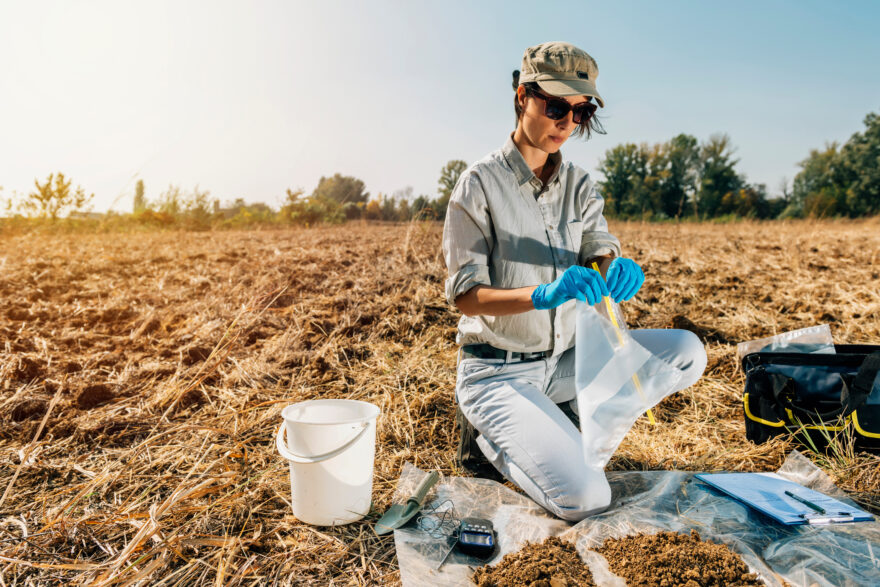One of the major goals in any successful construction project, is to have confidence that the structure you intend to build, will sit on a solid foundation.
To achieve this, a Geotechnical Engineer must analyse the qualities and engineering parameters of the soil, to understand the conditions present at the site.
The type of soil on a site, will determine the building foundation, therefore, soil testing is the cornerstone of any geotechnical investigation.
Remember, construction, and other building projects, are by nature highly disruptive processes and require activities that may shift the soil and disrupt the surrounding environment.
For example, acid sulfate soils, when left untouched, do not present any risk. But when they are exposed to air, toxic chemicals are released and can introduce many damaging effects to the nearby ecological life, waterways, air and even buildings. To effectively deal with acid sulfate soils, a joint environmental and geotechnical engineering approach is required to investigate, control, and manage the risks.
What does soil testing involve?
A Geotechnical Engineer or Soil Technician will visit the site to collect, test and analyse soil samples; helping them determine the characteristics, nature, and reactivity of the soil.
Soil testing can be divided into two key components:
- Field soil sampling & analysis
- Laboratory tests
Field sampling & analysis involves the collection of soil samples and documentation of other data, including existing soil strata and bearing capacity (for determining the suitability and amount of tolerable load on the soil). Engineers will also document the existence of any other factors that may affect the long-term stability of the designed foundations, e.g., trees, drainage, slope, depth to rock, existing structures, etc.
Laboratory testing is integral to geotechnical analysis and will help to determine things like the soil’s capacity to swell and shrink, its moisture content, soil permeability, dispersion, strength, consolidation, and direct shear.

In-field soil tests
Bore hole investigations allow geotechnical engineers to determine the nature and location of the different soil/rock layers, collect samples and carry out in situ tests. A record of all borehole locations is documented to obtain a clear understanding of the ground properties across the whole site.
Standard Penetration Tests (SPT) and Cone Penetration Tests (CPT) are the most frequently used field tests to estimate soil parameters for geotechnical analysis and design– find out more in our related article ‘Five Essential Geotechnical Tests’ here.
Shear Vane Tests help to determine the shear capacity of the in-situ soil. The test is carried out with equipment consisting of a rod with vanes mounted to it that is inserted into the ground and rotated. A gauge on the top of the rod measures the torque required to cause failure of the soil and provides a conversion to shear strength.
Field Nuclear Density Tests provide a measure of wet density and moisture content of compacted layers of earthworks fill or pavements up to a depth of 300mm to determine relative compaction.
Dynamic Cone Penetrometer (DCP) and Perth Sand Penetrometer (PSP) testing is used to assess the resistance of a soil to driving a cone tipped or blunt ended rod. Results may be used to infer shear strength and CBR of clayey soils and compaction and relative density of sand.

Laboratory soil tests
Samples collected in-field are sent to a geotechnical testing laboratory for testing and analysis. Common laboratory tests include:
Moisture content test
The moisture content of the soil is determined using several methods, including the oven-drying method, microwave method, hotplate method and sand bath method. The most common method is the oven-drying method, which involves weighing the sample soil, drying it in an oven (between 105 to 110 degrees Celsius), and weighing it again until constant dry mass has been achieved. The difference in the before and after weights is the weight of water in the soil.
Atterberg limits test
Atterberg limits tests determine the moisture contents at which fine-grained soils such as silt and clay transition between solid, semi-solid, plastic, and liquid states. Atterberg Limits are an inexpensive and well documented way of predicting the engineering properties of silt and clay soils. It is important for engineers to understand the behaviour of the soil as moisture content increases, as too much can lead to loss in overall shear strength and stability.
Compaction test
This test is conducted to determine the relationship between the moisture content and the dry density of a soil, when compacted using standard or modified compactive effort. This test can be used for establishing a maximum dry density and optimum moisture content for the determination of a range of other engineering properties such as relative density (when used in conjunction with the field nuclear test), CBR, permeability etc.
Shrink-swell index
The shrink/swell test is the relative change in volume to be expected with changes in moisture content, that is, the extent to which the soil shrinks as it dries out or swells when it gets wet. Extent of shrinking and swelling is influenced by the amount and kind of clay in the soil. The gives an understanding of the potential ground movement, which assist geotechnical engineers with footing design for structures.
NATA accredited laboratory
It is important to note that most of Douglas Partners’ 20 locations across Australia are equipped with NATA accredited laboratories.
This means our testing is compliant with current Australian Standards as well as some International Standards such as British Standards (BS), American Society of Testing and Materials (ASTM), various State and Territory test methods and In-house test methods.

